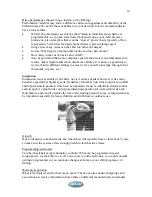
24
Description of the need and requirements should always precede description
of the final product.
•
Assessment methods and clinical trials.
The reviewer needs to be able to follow your team’s thought process. How did
they come to the conclusion that this is the appropriate device? A brief
description of the assessment methods will help them understand the proposed
equipment: client interview, mat assessment, driver training, pressure
mapping, trial in the home, trial in family vehicle, etc. When the reviewer sees
that a thorough assessment has been done, she is also more likely to approve
the recommendations.
•
Equipment chosen, justified item by item.
Everything on the wheelchair that has a charge needs to be separately
justified. For example, batteries – the wheelchair will not run without them
(may be obvious yet needs to be stated).
•
Utility of the device in the home.
Most funding sources require that any feature of the wheelchair has beneficial
effects in the client’s home setting. For example an elevating seat may help
access shelves and tables at school, but instead it should be justified by access
to family dining table, kitchen counters, bathroom sink, etc.
•
Why is it the best alternative?
Describe more economical alternatives that were considered, and why they
were not adequate. Denials like “choose a less costly alternative” are not
acceptable, as long as you can prove that there is no cost competitive
alternative with
the same or comparable features
.
•
How the device will benefit the user (refer back to the needs section)
•
What would happen to the user without this equipment?
Describe all the negative consequences of not having the equipment approved.
Depending on the equipment and client, this may include risk of falls and
fractures, development of secondary complications, learned helplessness, etc.
•
Focus on medical necessity.
A variety of definitions exist for medical necessity. If the equipment gets
denied stating “it is not medically necessary”, be sure to ask your insurance
for their specific definition. Focus your letter on medical features instead of
social or psychological. For example, a stander may allow for eye to eye
conversations and feeling of equality, but the LMN should rather focus on
prevention of osteoporosis, etc.
Denials:
In today’s funding environment getting equipment covered is ever increasingly difficult.
This may cause a lot of frustration and wasted time. Unfortunately, denials do occur even
with the best justification. Therefore you should always start the equipment process early.
A knowledgeable professional will be able to address many of the potential denial
reasons already in their original documentation.

































